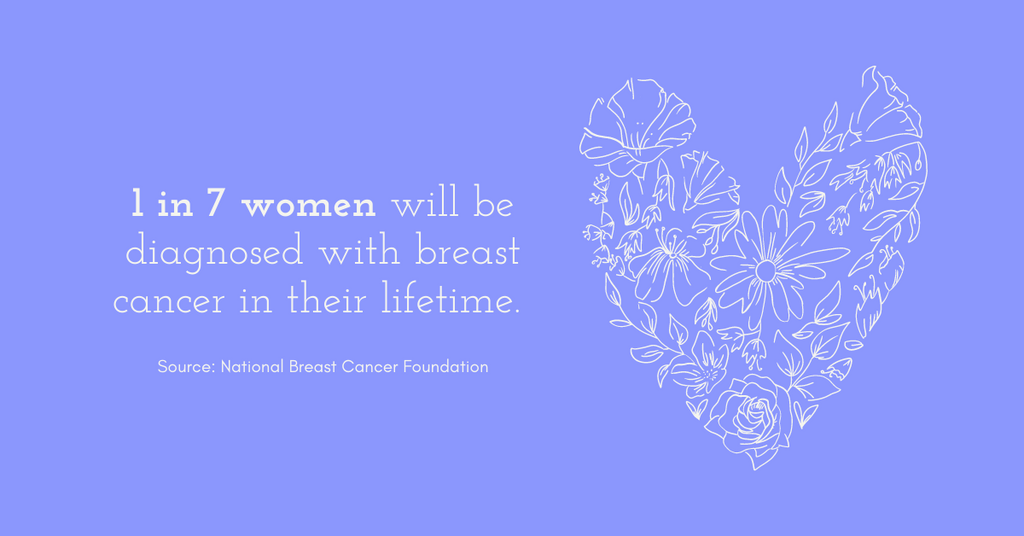Be Aware of Breast Cancer

Imagine this. On average, a woman is diagnosed with breast cancer every two minutes in the United States. That’s according to the National Breast Cancer Foundation who also says there are some 3.8 million women with a history of breast cancer currently living in the U.S. That number includes women who are cancer-free and others who still have some evidence of cancer and may be undergoing treatment. For perspective, Los Angeles has a population of about 3.9 million.

So what is breast cancer exactly? Here’s the definition from the American Cancer Society.
Breast cancer is a group of diseases in which cells in breast tissue change and divide uncontrolled, typically resulting in a lump or mass. Most breast cancers begin in the lobules (milk glands) or in the ducts that connect the lobules to the nipple.
We all need to be clear on the fact that breast cancer is the second most common cancer among American women, right after skin cancer. Worldwide, it’s number one. This year, it’s estimated that 30% of all new cancers diagnosed in women will be breast cancer.
Breast Anatomy
To understand breast cancer, it’s helpful to understand the anatomy of the breast. Here’s the word from the experts at Johns Hopkins.
- Each breast has 15 to 20 sections, called lobes. They are arranged like the petals of a daisy.
- Each lobe has many smaller structures called lobules. These end in dozens of tiny bulbs that can produce milk.
- The lobes, lobules, and bulbs are all linked by thin tubes called ducts.
- These ducts lead to the nipple in the center of a dark area of skin called the areola.
- Fat fills the spaces between lobules and ducts.

- There are no muscles in the breast, but muscles lie under each breast and cover the ribs.
-
Each breast also contains blood vessels and vessels that carry lymph. The lymph nodes are found in clusters under the arm, above the collarbone, and in the chest. They are also in many other parts of the body.
Early Detection
Early detection is so important when it comes to cancer – and breast cancer is no exception. While there are symptoms that can alert us to breast cancer like abnormal lumps, this is not a reliable warning system, because many people do not notice lumps or experience symptoms. The bottom line is early detection leads to early treatment which results in better outcomes. Much better, according to the American Cancer Society. The 5-year relative survival rate is 99% when breast cancer is detected early and has not spread outside the breast.

It was during the 1980s, when breast cancer survival rates began to improve in countries with early detection programs and treatment advancements. In the U.S., from 1989 to 2017, deaths from breast cancer dropped by 40%, according to the American Cancer Society. One way we can all keep that number moving in the right direction is by keeping up with the screening that’s recommended for our age and medical history.
Breast Cancer Screening
Mammograms are the most common screening test for breast cancer. There are three types:
- Film mammography – an x-ray of the breasts
- Digital mammography – a computer picture of the breast
- Digital breast tomosynthesis (DBT) – a 3D picture of the breast made from a series of x-rays taken at different angles
If an area of concern is discovered from a mammogram, additional testing will be needed. Ultrasounds, MRIs and biopsies are sometimes the next step to diagnose or to determine whether or not further testing is required.
Most of us are aware that we should be getting regular mammograms. Women ages 40 to 44 may opt to start getting them, but by 45 it’s a must. Some women switch to every two years after age 55. Your health care professional can help you decide on the strategy that’s best for you and your particular circumstances.
Want to know more about mammograms? The American Cancer Society is a good source of information on the subject. Click here to go there.
Types of Breast Cancer
When it comes to describing breast cancer, it’s helpful to know that there are two categories: in-situ and invasive. Here's the basics on both.
In-situ means in its original place. When it comes to breast cancer, it means that the cancer cells are contained within the ducts or lobules.
Ductal carcinoma in situ (DCIS) aka intraductal carcinoma or stage 0 breast cancer is non-invasive, because it’s contained within the ducts and has not spread to other breast tissue. DCIS is also referred to as pre-invasive breast cancer. This is a highly treatable form of breast cancer – close to 100%.

Invasive
Invasive – or infiltrating – breast cancer has spread to surrounding breast tissue. The most common forms of invasive breast cancer are Invasive Ductal Carcinoma (IDC) and Invasive Lobular Carcinoma (ILC). IDC accounts for about 70-80% of all breast cancers.
There are other forms of invasive breast cancer. The National Breast Cancer Foundation is a good resource for descriptions of the less common types. Click here to get more details on the subject.
Grading
A grading system is used to help predict how cancer will grow and spread. Basically, grading comes down to how much cancer cells resemble normal cells. There are three grades that can also be described as well-differentiated, moderately differentiated and poorly differentiated. Lower grades generally mean that the cancer is slow-growing and is less likely to spread. A higher grade means the cancer is expected to be faster-growing and more likely to spread. Three samples are taken in order to grade breast cancer, then each sample is given a score and added up to determine the grade.
Score 3, 4, 5 = Grade 1 (well differentiated)
Score 6, 7 = Grade 2 (moderately differentiated)
Score 8, 9 = Grade 3 (poorly differentiated)
There’s a lot more to know about pathology reports. The American Cancer Society has a good description. Click here.

Staging
Staging has to do with the spread of cancer in the body. Doctors will determine how much cancer is in the body and how it has spread (or not) to determine the stage. The lower the number, the less the spread. Staging is important, because it helps to determine how serious the cancer is and how to treat it.
There are two approaches to staging: pathologic (or surgical) stage and clinical stage which is done when surgery isn’t possible. It can be less reliable than pathologic stage. Both methods use seven criteria:
- Size of the tumor
- Spread to nearby lymph nodes
- Metastasis (spread to distant sites)
- Estrogen receptor status
- Progesterone receptor status
- Her2 status
- Cancer grade
Here are the stages of breast cancer as described by the Memorial Sloan Kettering Cancer Center:
Stage 0: Abnormal cells are present but have not spread to nearby tissue.
Stage I: Early Stage – Cancer has spread to other tissue in small area.
Stage II: Localized – Tumor is between 20 – 50mm and some lymph nodes are involved or a tumor larger than 50mm with no lymph nodes involved.
Stage III: Regional Spread – Tumor is larger than 50mm, with more lymph nodes involved across a wider region. In some cases, there is no tumor present at all. Cancer may have spread to skin or chest wall.
Stage IV: Distant Spread – Cancer has spread beyond the breast to other parts of the body.
There’s a lot to know about staging. Click here (back to the experts at the American Cancer Society), if you’re interested in those kind of details.
Treatment
Treatment for breast cancer depends on several factors including the type of cancer, the grade and stage, size, and sensitivity to hormones plus overall health and personal preferences. Most women have surgery – lumpectomy or mastectomy – and oftentimes surgery is followed by additional treatment like radiation, chemotherapy or hormone therapy.
For more information about treatment for breast cancer, click here to see what the professionals at the M.D. Anderson Cancer Center have to say on the subject.
Risks
There are known risks for developing breast cancer. However, it’s also true that people without risk factors are diagnosed every day and many people with risk factors never develop breast cancer.
Here are some of the risk factors, based on sources listed at the end of this blog:
- Lifestyle & environment
- Personal or family history of breast cancer, including DCIS and LCIS
- Noncancerous cell abnormalities
- Inherited gene mutations like BRCA1 and BRCA2
- Elevated lifetime estrogen exposure including:
- Early onset of menstruation (before age 11)
- Late onset of menopause (after age 55)
- Older age of first childbirth (after age 30) or never having given birth
- Taking estrogen and progesterone after menopause
- Having breast tissue that is more dense with lobular and ductal tissue relative to fatty tissue
- Obesity
- Prior radiation to chest area
- Consuming excessive alcohol
Prevention
Research is ongoing and suggests that healthy lifestyle may reduce the risk of breast cancer. Of course, avoiding things known to cause cancer is of the utmost importance. Some women at high risk take medicine or undergo risk-reducing surgery (mastectomy and oophorectomy) to prevent breast cancer.
The Mayo Clinic recommends these five ways to lower your risk:
-
Limit alcohol. To one drink per day.
-
Maintain a healthy weight.
-
Be physically active. Most healthy adults should aim for at least 150 minutes a week of moderate aerobic activity or 75 minutes of vigorous aerobic activity weekly, plus strength training at least twice a week.
- Breast-feed. Breast-feeding might play a role in breast cancer prevention. The longer you breast-feed, the greater the protective effect.
- Limit postmenopausal hormone therapy. Combination hormone therapy (estrogen and progesterone) may increase the risk of breast cancer. So carefully consider the risks and benefits. This is something to discuss with your doctor.
Myths
According to the National Cancer Institute, the following have little to no effect on the risk of developing breast cancer:
- Having an abortion.
- Making diet changes such as eating less fat or more fruits and vegetables.
- Taking vitamins, including fenretinide (a type of vitamin A).
- Cigarette smoking, both active and passive (inhaling secondhand smoke).
- Using underarm deodorant or antiperspirant.
- Taking statins (cholesterol-lowering drugs).
- Taking bisphosphonates (drugs used to treat osteoporosis and hypercalcemia) by mouth or by intravenous infusion.
- Changes in your circadian rhythm (physical, mental, and behavioral changes that are mainly affected by darkness and light in 24 hour cycles), which may be affected by working night shifts or the amount of light in your bedroom at night.
There's a lot to know, when it comes to breast cancer. The number one thing to remember is to stay on top of your regular screening schedule and any follow up that your doctor recommends. Also, be familiar with your own breasts, so you will recognize changes. And, of course, lets all stay tuned into our overall health by keeping active, eating nutritious food and getting adequate sleep.
Here's to all the women who have fought and to those who are still fighting.
Sources:
National Breast Cancer Foundation
American Cancer Society
Susan G. Komen
The Natonal Cancer Institute
Breastcancer.org
World Health Organization
Memorial Sloan Kettering Cancer Center
M.D. Anderson
Mayo Clinic


Leave a comment